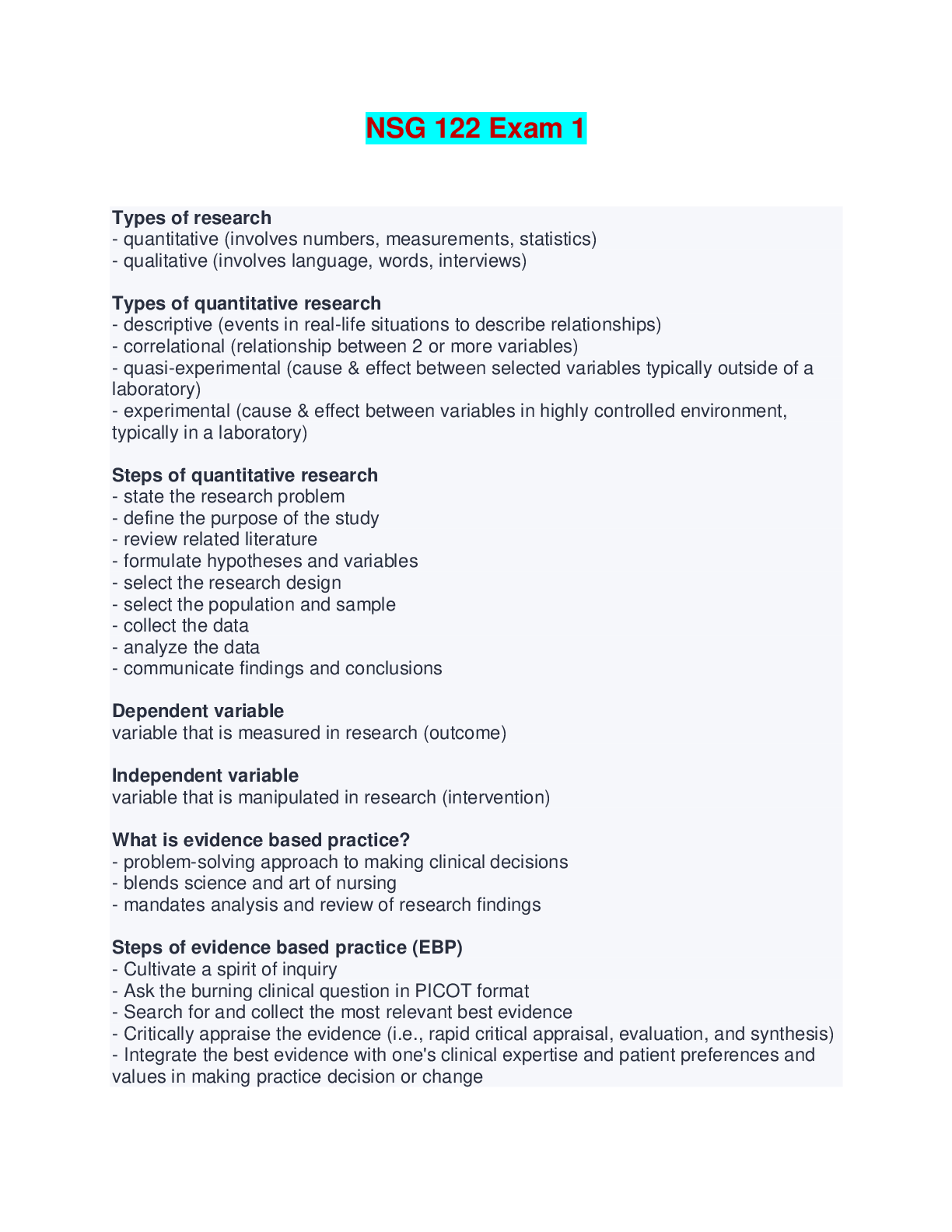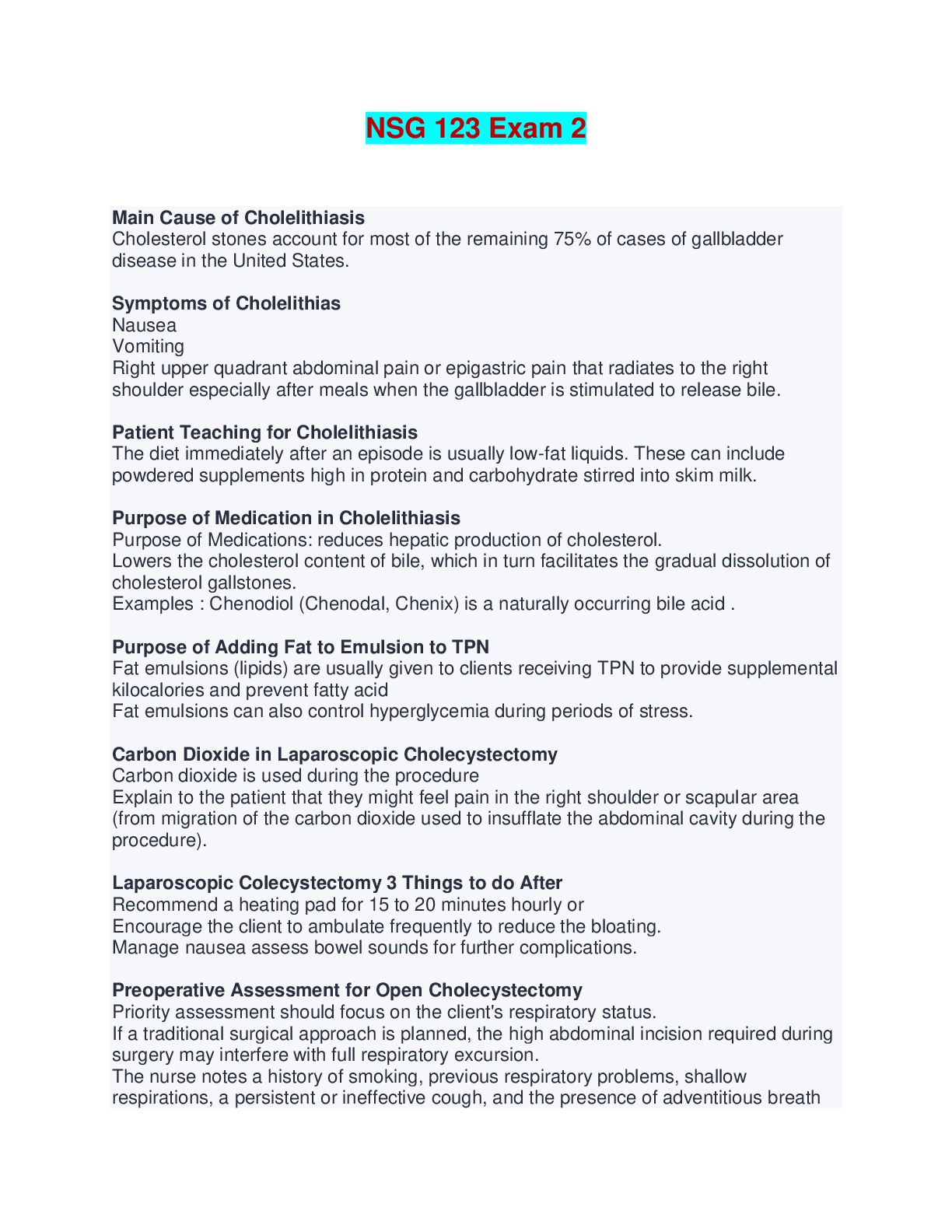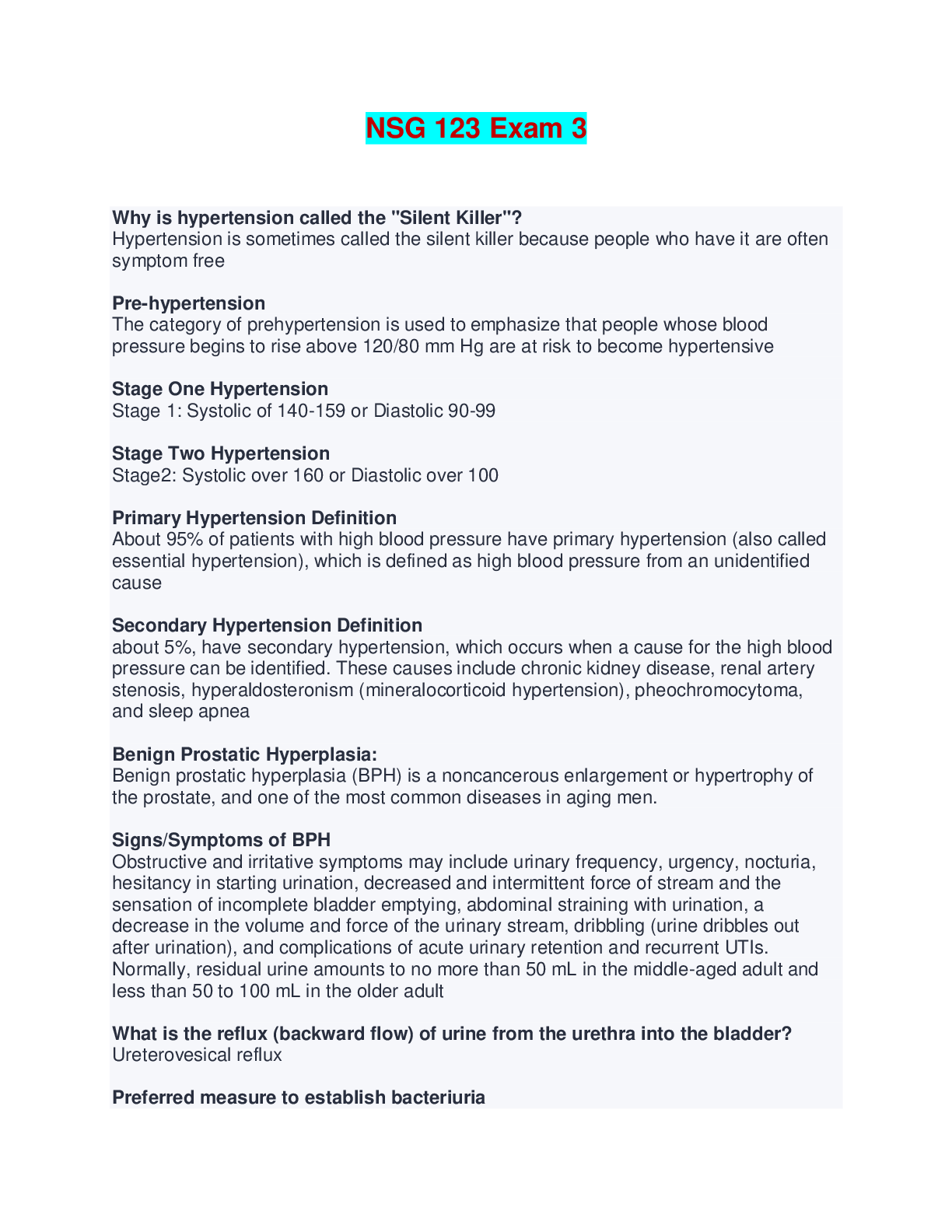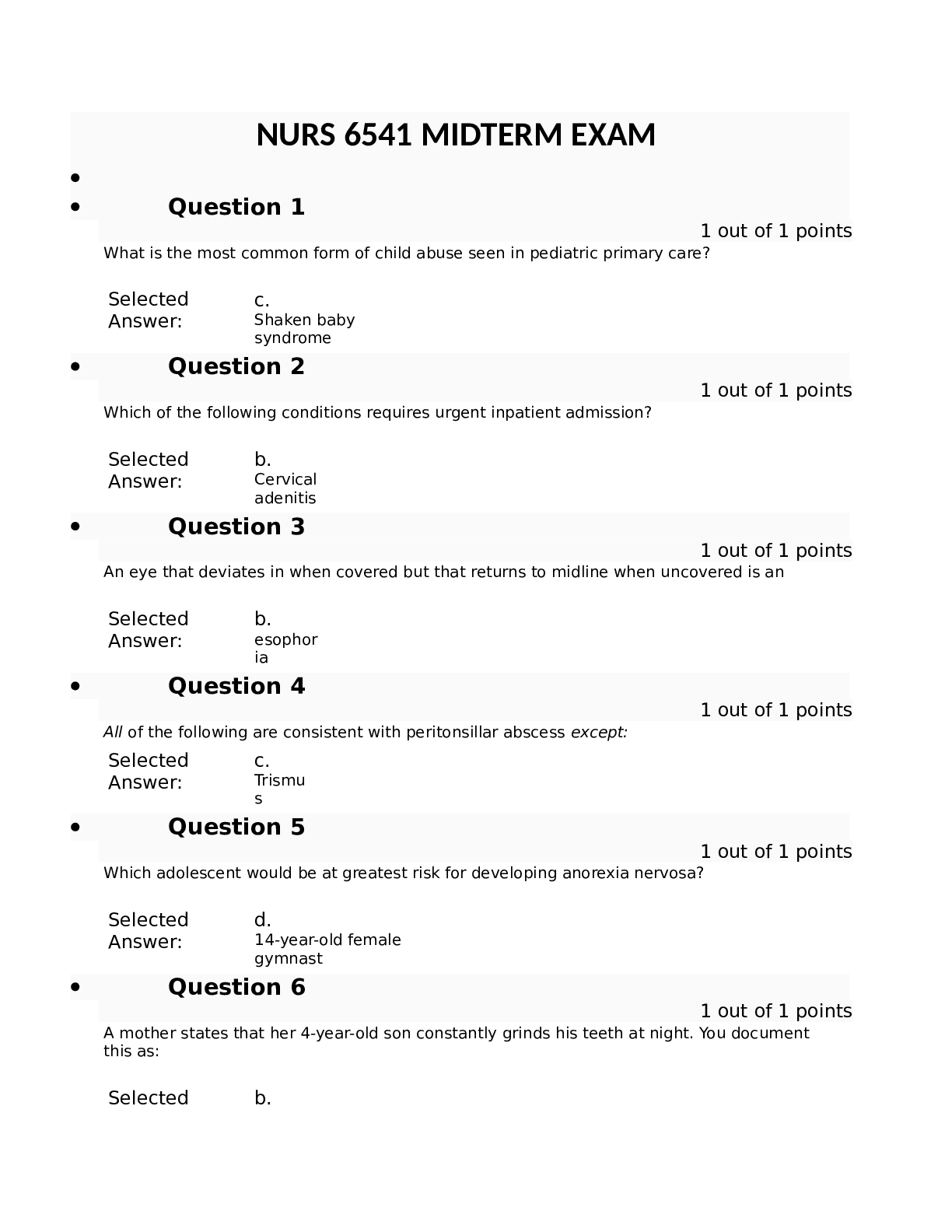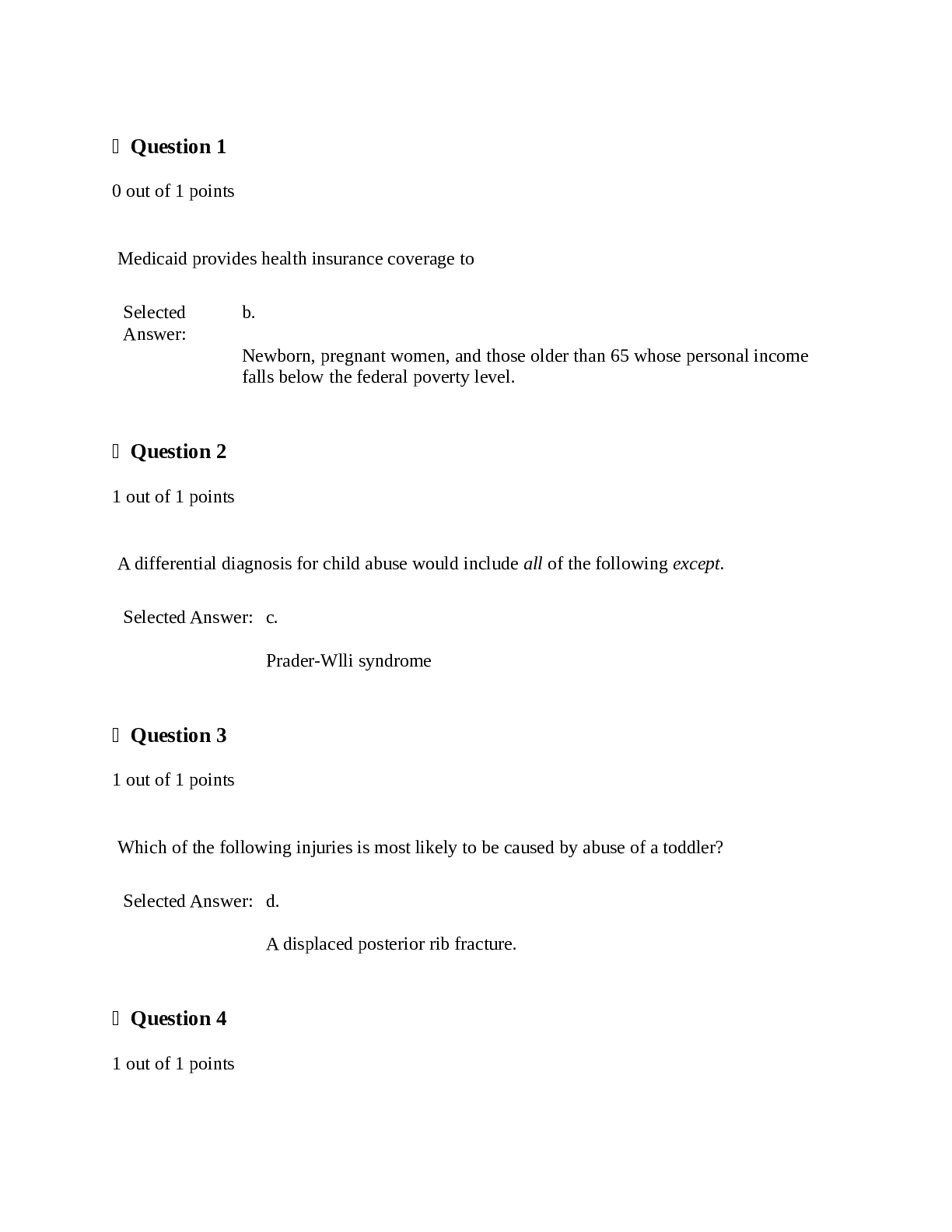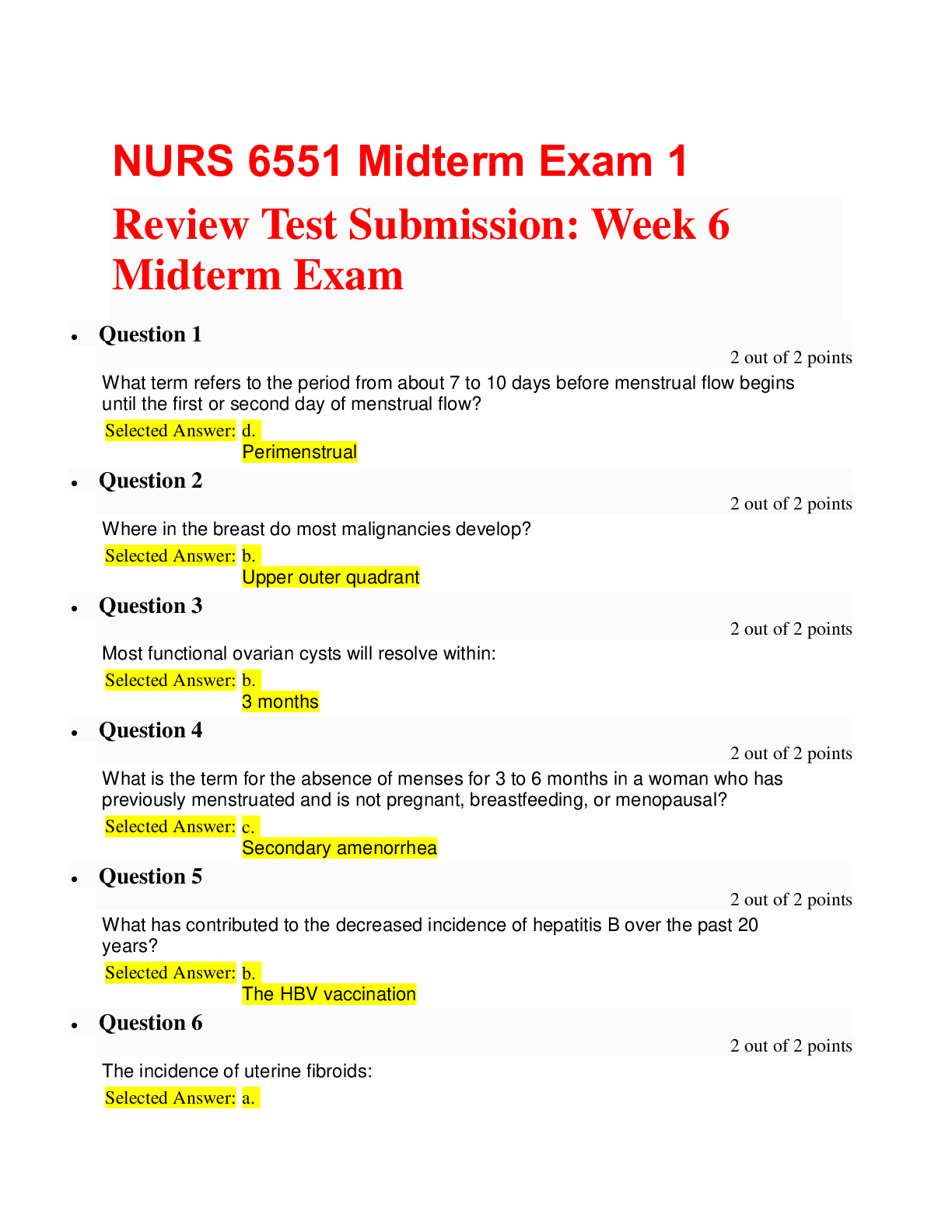SOC 3420 Criminology 9-11 | Questions with 100% Correct Answers
Document Content and Description Below
SOC 3420 Criminology 9-11 | Questions with 100% Correct Answers The integrative methodology in the early research of __________ formed the basis of today's developmental approach. a. Keith J. Bell ... and Paul M. Klenowski b. Eleanor Glueck and Sheldon Glueck c. Rolf Loeber and Marc LeBlanc d. Marvin Wolfgang and Terri Moffitt REFERENCES: Foundations of Developmental Theory Public policy programs based on developmental theory ______. a. focus on deterrence through strict punishments b. include mechanisms for reintegrating offenders into society c. provide self-help treatments aimed at adult offenders d. feature multisystemic treatments designed for at-risk youths REFERENCES: Foundations of Development Theory Developmental theories attempt to provide a natural history of criminal careers by encompassing ______. a. its onset, continuation, and termination b. delinquency and criminal behaviors c. unidimensional and multidimensional treatment efforts d. offenders' race/ethnicity, age, and gender REFERENCES: Foundations of Developmental Theory Latent trait theorists believe human development is controlled by a master trait present at birth or soon after that results in ______. a. low intellectual development b. verbal and physical aggression c. an increased propensity to commit crime d. a reduced ability to interpret social interactions REFERENCES: Foundations of Developmental Theory How do life course theorists view criminality? a. As an inflexible process b. As a dynamic process c. As an opportunity-driven process d. As a static process REFERENCES: Foundations of Developmental Theory Why is early onset an important factor in crime? a. Because the earlier that antisocial behavior is identified, the earlier that turning points can be implemented b. Because latent traits may have gone unnoticed or unidentified at birth c. Because early onset of antisocial behavior predicts later and more serious criminality d. Because early onset of antisocial behavior is void of the crime-non-crime choice mechanism suggested by Wilson and Herrnstein. REFERENCES: Life Course Theory One of the key principles of life course theory is that ______. a. high verbal ability during childhood predicts persistence b. persistent offenders begin their offending careers in late adolescence c. the earlier the onset of criminality, the more specialized and violent the criminal career d. the seeds of a criminal career are planted early in life REFERENCES: Life Course Theory According to life course theories, criminal opportunity, effective guardianship, and apprehension risk are __________ factors that can explain the onset, continuance, and desistance from crime. a. personal b. social c. cognitive d. situational REFERENCES: Life Course Theory Which is an inaccurate statement about problem behaviors and problem behavior syndrome? a. All varieties of criminal behavior may be a part of a generalized problem behavior syndrome. b. People suffering from one problem behavior condition typically exhibit many symptoms of the rest. c. The more risk factors a person suffers, the greater the likelihood they will engage in antisocial behavior. d. Problem behavior syndrome portrays crime as the product of other social problems. REFERENCES: 228-229 Using data from a longitudinal study of Pittsburgh youth, Loeber identified distinct pathways to crime. Which pathway begins at an early age with stubborn behavior? a. The authority conflict pathway b. The covert pathway c. The overt pathway d. The late bloomer pathway REFERENCES: Life Course Theory Life course theories integrate personal, social, socialization, situational, and cognitive factors to explain human behavior. Personality and intelligence are __________ factors that can explain the onset and continuation of criminality. a. personal b. social c. socialization d. cognitive REFERENCES: Life Course Theory Life course theorists examine offending patterns and trends. Terrie Moffit describes adolescent-limited offenders as ______. a. angry adolescents b. typical teenagers c. classic persisters d. standard youth REFERENCES: Trajectory Theory Sampson and Laub's research indicates that building __________ and strong social bonds reduces the likelihood of long-term deviance. a. knowledge b. social capital c. marketable skills d. financial capital REFERENCES: Age-Graded Theory Which of the following is not one of the significant life-changing events that reduces criminality, according to Laub and Sampson? a. Buying a car b. Joining the military c. Getting married d. Getting a job REFERENCES: Age-Graded Theory Laub and Sampson identify life events that enable adult offenders to desist from crime. Accordingly, they identify transitions as short-term events embedded in ______. a. trajectories b. social capital c. marital relationships d. pathways REFERENCES: Age-Graded Theory According to Laub and Sampson, the life-changing events that alter the development of a criminal career are called ______. a. turning points b. hot spots c. event dependencies d. cumulative disadvantages REFERENCES: Age-Graded Theory Cognitive frameworks that help people quickly process and sort through information are called ______. a. schemas b. latent traits c. criminogenic structure d. impulsive controls REFERENCES: Age-Graded Theory Which of the following statements is inaccurate in terms of the empirical research supporting Laub and Sampson's age-graded theory? a. Criminality appears to be dynamic and is affected by behaviors occurring over the life course. b. People who get involved with the justice system as adolescents may find that their career paths are blocked well into adulthood. c. Criminal career trajectories are impossible to reverse, even if life conditions improve. d. Accumulating social capital reduces crime rates. REFERENCES: Age-Graded Theory According to latent trait theory, when does a latent trait appear? a. At birth or soon after b. During childhood c. During adolescence d. During early adulthood REFERENCES: Latent Trait/ Propensity Trait According to Wilson and Herrnstein's crime and human nature view, a criminal incident occurs when an individual chooses criminal over conventional behavior. What factor influences that choice? a. Social capital b. A latent trait c. Low self-control d. Peer influence REFERENCES: Latent Trait/ Propensity Theory Which of the following statements regarding gender differences and the general theory of crime is accurate? a. The GTC predicts gender differences in self-control and crime. b. There is little evidence that males are more impulsive than females. c. Females are more likely to persist in crime due to low self-control. d. Male juvenile offenders exhibit greater impulse control than female juvenile offenders until approximately 16 years of age when levels equalize. REFERENCES: General Theory of Crime (GTC) In their general theory of crime, Gottfredson and Hirschi consider the criminal offender and the criminal act as _______concepts. a. separate b. balanced c. competing d. opposite REFERENCES: General Theory of Crime (GTC) According to the general theory of crime, being adventuresome, physical, and self-centered are all signs that a person possess ______. a. high self-esteem b. low self-esteem c. high self-control d. low self-control REFERENCES: General Theory of Crime (GTC) Gottfredson and Hirschi trace the root cause of poor self-control to ______. a. lack of education b. inadequate child-rearing practices c. weak social bonds d. peer associations REFERENCES: General Theory of Crime (GTC) Gottfredson and Hirschi claim that the principles of self-control theory ______. a. predominantly explain violent crime b. predominantly explain property crime c. predominantly explain street crime d. can explain all varieties of criminal behavior REFERENCES: General Theory of Crime (GTC) Although criminal offenders are people predisposed to crime, they are not robots who commit crime without restraint. According to the general theory of crime, change in the frequency of criminal activity is a function of ______. a. change in one's level of impulsivity b. change in one's level of self-control c. change in criminal opportunity d. change in environmental conditions REFERENCES: General Theory of Crime (GTC) A pathway to deviance that begins at an early age with stubborn behavior and leads to property damage, and eventually escalates to more serious forms of theft and fraud. a. Authority conflict pathway b. Overt pathway c. Covert pathway d. Design pathway REFERENCES: Trajectory Theory A pathway to a criminal career that begins with minor aggression and eventually escalates to violent crime. a. Overt pathway b. Covert pathway c. Golden pathway d. Authority conflict pathway REFERENCES: Trajectory Theory According to psychologist Terrie Moffit, most young offenders follow one of two paths; adolescent-limited and ______. a. life course persisters b. age of onsetters c. adolescent pre-disposers d. abstainers REFERENCES: Trajectory Theory Adolescents who do not engage in any deviant behavior, a path which places them outside the norm for their age group are called ______. a. abstainers b. absentee criminals c. non-utilitarians d. double marginalizationers REFERENCES: Trajectory Theory Catherine was adopted at the age of 6. She is currently 14 years of age, attends public high school in Baton Rouge, Louisiana, and her mother is a stay-at-home mom, while her father recently lost his job as a lumberjack due to new deforestation laws. Using this information, ANSWER the following questions. Catherine has been diagnosed with Problem Behavior Syndrome after she began using drugs, began experimenting sexually, and her health declined which is one reason she unsuccessfully attempted suicide. According to PBS, of the three subcategories of the theory, Catherine's issue most likely is ______. a. personal b. functional c. environmental d. overt REFERENCES: Life Course Theory KEYWORDS: Bloom's: Applying Doctors have told Catherine's parents that her behavior is lacking thought or deliberation in decision making. This behavior would be considered ______. a. impulsive b. imprudent c. controlling d. age graded REFERENCES: General Theory of Crime (GTC) KEYWORDS: Bloom's: Applying If Catherine's criminal behavior began with minor behavior (shoplifting, lying) and eventually escalated to more serious forms of criminality, such as using stolen credit cards or dealing drugs, she most likely would be considered as taking which of the following pathways? a. Covert b. Authority conflict c. Overt d. Avoidance REFERENCES: Trajectory Theory KEYWORDS: Bloom's: Applying Personal traits can account for violent behavior. Psychologist Dorothy Ottnow Lewis found that murderous youths often suffer signs of ___________. a. genetic impairments b. intellectual dysfunction c. neurological impairments d. personality disorders REFERENCES: Causes of Violence Sigmund Freud believed that human aggression and violence are produced by instinctual drives. ____ is the death instinct that is sometimes expressed externally as violence or internally as suicide and alcoholism. a. Hostility b. Eros c. Narcissism d. Thanatos REFERENCES: Causes of Violence Children exposed to violence at home, at school, or in the environment may adopt violent methods themselves. Which children are most likely to engage in violent behavior? a. Children exposed to a single act of gun violence b. Children exposed to violence in the home c. Children exposed to violence in the home and who live in a neighborhood with high violence rates d. Children living in areas marked by extreme violence REFERENCES: Causes of Violence Frank is a drug user. Frank robs a store to support his heroin habit. This is an example of _______. a. economic compulsive behavior b. pharmacological violence c. systemic violence d. psychopharmacological violence REFERENCES: Causes of Violence A segment of society in which violence has become legitimized by the custom and norms of that group. a. Subculture of violence b. Economic compulsive behavior c. Systemic link d. Pharmacological violence REFERENCES: Causes of Violence The Uniform Crime Report indicates that __________ of all murders and about 40 percent of all robberies involve firearms. a. 33 percent b. 70 percent c. 50 percent d. 90 percent REFERENCES: Causes of Violence Catherine and Gloria regularly crush up prescription pain meds at work and snort them. When they do this they usually become confrontational with coworkers as a result. This is a ______. a. psychopharmacological relationship b. compulsive relationship c. systemic relationship d. stratified relationship REFERENCES: Causes of Violence The common law definition of rape derives from the Latin word rapere meaning ______ and is defined as "the carnal knowledge of a female forcibly and against her will." a. to take by right b. to take by force c. to take by surprise d. to take by compulsion REFERENCES: Rape Sexual relations between an underage minor female and an adult male. a. Statutory rape b. Systemic rape c. Marital rape d. Sadistic rape REFERENCES: Rape Diana Russel's concept of the virility mystique reflects which causal factor of why men commit rape? a. Male socialization b. Psychological abnormality c. Social learning d. Evolution REFERENCES: Rape According to Groth, 40 percent of rapists he studied were ______. a. sexually victimized as adults b. sexually victimized as adolescents [Show More]
Last updated: 7 months ago
Preview 5 out of 22 pages

Loading document previews ...
Buy this document to get the full access instantly
Instant Download Access after purchase
Buy NowInstant download
We Accept:

Also available in bundle (1)

SOC 3420 CRIMINOLOGY CH 7-14 BUNDLE
SOC 3420 CRIMINOLOGY CH 7-14 BUNDLE
By Ajay25 7 months ago
$22
3
Reviews( 0 )
$16.00
Can't find what you want? Try our AI powered Search
Document information
Connected school, study & course
About the document
Uploaded On
Oct 09, 2024
Number of pages
22
Written in
Additional information
This document has been written for:
Uploaded
Oct 09, 2024
Downloads
0
Views
46

